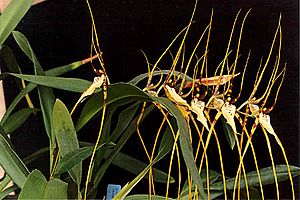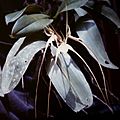Brassia facts for kids
Quick facts for kids Brassia |
|
|---|---|
 |
|
| Brassia arcuigera | |
| Scientific classification |
|
| Kingdom: | Plantae |
| Clade: | Tracheophytes |
| Clade: | Angiosperms |
| Clade: | Monocots |
| Order: | Asparagales |
| Family: | Orchidaceae |
| Subfamily: | Epidendroideae |
| Tribe: | Cymbidieae |
| Subtribe: | Oncidiinae |
| Genus: | Brassia R.Br., 1813 |
| Type species | |
| Brassia maculata R.Br. in W.T.Aiton (1813)
|
|
| Synonyms | |
|
|
Brassia is a group of beautiful orchids. They are often called spider orchids because their long, thin petals and sepals look a bit like spider legs! These amazing plants grow naturally in places like Mexico, Central America, the Caribbean, and northern South America. One type, called B. caudata, even grows in Florida.
The name Brassia comes from William Brass. He was a British botanist and artist who collected plants a long time ago. If you see Brassia in a plant shop, its short name is Brs.
Contents
What Makes Brassia Orchids Special?
Brassia orchids and their popular hybrids (mixtures of different types) are often grown by people. They are famous for their very long, spreading petals and sepals, which can sometimes be longer than 50 centimeters! This is why they got their nickname, "spider orchid." One special type, called 'Eternal Wind', even won an award for being a great garden plant.
Where Do Spider Orchids Live?
These orchids are epiphytes. This means they grow on other plants, like trees, instead of in the ground. They love wet forests, from sea level up to about 1,500 meters high. Many different Brassia types are found in the Andes mountains in Peru. While most Brassia species live in specific areas, Brassia caudata can be found across a much wider region.
How Do Brassia Flowers Look?
Brassia orchids have large, oval-shaped pseudobulbs, which are like swollen stems that store water and nutrients. Each pseudobulb usually has one or two leaves at the top. The flowers grow on a long stem that comes from the base of the plant. Each flower has small leaf-like parts called bracts. The special lower petal, called the lip, is not attached to the main column of the flower.
How Do Spider Orchids Get Pollinated?
Brassia orchids have a super clever way to get pollinated! They use a trick called mimicry. They look and even smell like something that attracts certain insects. In this case, they attract female spider-hunter wasps!
Here's how it works: The orchid's flower looks like a spider, which is what these wasps hunt. When a wasp sees the flower, it thinks it's found a spider to sting and catch. The wasp tries to sting the orchid's lip, but of course, there's no spider there! As the wasp moves around, trying to grab its "prey," it accidentally brushes against the orchid's pollen. The pollen sticks to the wasp's head. When the wasp flies to another Brassia flower and tries the same trick, it leaves the pollen behind, pollinating the new flower. It's a really smart plant trick!
Types of Brassia Orchids
As of 2014, there are many accepted types of Brassia orchids. Here are some of them:
- Brassia allenii - Found in Honduras, Panama
- Brassia andina - Found in Colombia, Ecuador, Peru
- Brassia andreettae - Found in Ecuador
- Brassia angusta - Found in Venezuela, Guyana, northern Brazil
- Brassia angustilabia - Found in Panama, Brazil
- Brassia arachnoidea - Found in Rio de Janeiro
- Brassia arcuigera - Found in Honduras, Costa Rica, Panama, Colombia, Venezuela, Ecuador, Peru
- Brassia aurantiaca - Found in Colombia, Venezuela, Ecuador
- Brassia aurorae - Found in Peru
- Brassia bennettiorum - Found in Peru
- Brassia bidens - Found in Venezuela, Guyana, northern Brazil
- Brassia bowmanii - Found in Colombia
- Brassia brachypus - Found in Ecuador, Peru, Bolivia
- Brassia brevis - Found in Colombia, Ecuador
- Brassia brunnea - Found in Guatemala
- Brassia caudata - Found in Mexico, Central America, Florida, Caribbean, northern South America
- Brassia cauliformis - Found in Peru
- Brassia chloroleuca - Found in Guyana, French Guiana, Brazil
- Brassia chlorops - Found in Nicaragua, Costa Rica, Panama
- Brassia cochleata - Found in northern South America
- Brassia cyrtopetala - Found in Colombia
- Brassia diphylla - Found in Colombia
- Brassia dresslerorum - Found in Guatemala
- Brassia ecuadorensis - Found in Ecuador
- Brassia endresii - Found in Central America
- Brassia escobariana - Found in Colombia
- Brassia euodes - Found in Colombia, Ecuador, Peru
- Brassia farinifera - Found in Ecuador
- Brassia filomenoi - Found in Peru
- Brassia forgetiana - Found in Peru, Brazil, Venezuela
- Brassia garayana - Found in Ecuador, Peru
- Brassia gireoudiana - Found in Costa Rica, Panama
- Brassia glumacea - Found in Colombia, Venezuela, Ecuador, Peru
- Brassia glumaceoides - Found in Colombia, Venezuela
- Brassia horichii - Found in Costa Rica, Panama
- Brassia huebneri - Found in French Guiana, Brazil
- Brassia iguapoana - Found in Brazil
- Brassia incantans - Found in Colombia, Ecuador, Peru
- Brassia jipijapensis - Found in Ecuador
- Brassia keiliana - Found in Colombia, Venezuela, Guyana
- Brassia koehlerorum - Found in Peru
- Brassia lanceana - Found in Panama, Trinidad & Tobago, northern South America
- Brassia macrostachya - Found in Venezuela, Guyana
- Brassia maculata - Found in Mexico, Central America, Cuba, Jamaica
- Brassia mendozae - Found in Ecuador
- Brassia minutiflora - Found in Colombia
- Brassia neglecta - Found in Guyana, Venezuela, Bolivia, Colombia, Ecuador, Peru
- Brassia ocanensis - Found in Venezuela, Bolivia, Colombia, Ecuador, Peru
- Brassia panamensis - Found in Panama
- Brassia pascoensis - Found in Peru
- Brassia peruviana - Found in Peru
- Brassia pozoi - Found in Ecuador, Peru
- Brassia pumila - Found in Guyana, Venezuela, French Guiana, Colombia, Peru, Brazil
- Brassia rhizomatosa - Found in Venezuela, Peru
- Brassia rolandoi - Found in Peru
- Brassia signata - Found in Peru, Bolivia, Oaxaca, Guerrero
- Brassia suavissima - Found in Costa Rica
- Brassia sulphurea - Found in Venezuela
- Brassia thyrsodes - Found in Bolivia
- Brassia transamazonica - Found in Peru
- Brassia verrucosa - Found in Mexico, Central America, Venezuela, Brazil
- Brassia villosa - Found in Guyana, Venezuela, Brazil
- Brassia wageneri - Found in Guyana, Venezuela, Brazil, Colombia, Peru
- Brassia warszewiczii - Found in Ecuador
Hybrid Orchids with Brassia
Orchid growers often cross different types of orchids to create new and exciting hybrid plants. Many of these hybrids include Brassia in their family tree. Here are some of the groups of hybrid orchids that have Brassia as one of their parents:
- ×Alexanderara (Brassia × Cochlioda × Odontoglossum × Oncidium)
- ×Aliceara (Brassia × Miltonia × Oncidium)
- ×Bakerara (Brassia × Miltonia × Odontoglossum × Oncidium)
- ×Banfieldara (Ada × Brassia × Odontoglossum )
- ×Beallara (Brassia × Cochlioda × Miltonia × Odontoglossum )
- ×Brapasia (Aspasia × Brassia)
- ×Brassada (Ada × Brassia)
- ×Brassidium (Brassia × Oncidium)
- ×Brassioda (Brassia × Cochlioda)
- ×Brassochilus (Brassia × Leochilus)
- ×Brilliandeara (Aspasia × Brassia × Cochlioda × Miltonia × Odontoglossum × Oncidium)
- ×Crawshayara (Aspasia × Brassia × Miltonia × Oncidium)
- ×Degarmoara (Brassia × Miltonia × Odontoglossum )
- ×Derosaara (Aspasia × Brassia × Miltonia × Odontoglossum )
- ×Duggerara (Ada × Brassia × Miltonia)
- ×Eliara (Brassia × Oncidium × Rodriguezia)
- ×Forgetara (Aspasia × Brassia × Miltonia)
- ×Goodaleara (Brassia × Cochlioda × Miltonia × Odontoglossum × Oncidium)
- ×Hamiltonara (Ada × Brassia × Cochlioda × Odontoglossum )
- ×Johnkellyara (Brassia × Leochilus × Oncidium × Rodriguezia)
- ×Maclellanara (Brassia × Odontoglossum × Oncidium)
- ×Miltassia (Brassia × Miltonia)
- ×Norwoodara (Brassia × Miltonia × Oncidium × Rodriguezia)
- ×Odontobrassia (Brassia × Odontoglossum)
- ×Pettitara (Ada × Brassia × Oncidium)
- ×Roccaforteara (Aspasia × Brassia × Cochlioda × Odontoglossum)
- ×Rodrassia (Brassia × Rodriguezia)
- ×Rohriara (Ada × Aspasia × Brassia)
- ×Sanderara (Brassia × Cochlioda × Odontoglossum)
- ×Sauledaara (Aspasia × Brassia × Miltonia × Oncidium × Rodriguezia)
- ×Schafferara (Aspasia × Brassia × Cochlioda × Miltonia × Odontoglossum)
- ×Shiveara (Aspasia × Brassia × Odontoglossum × Oncidium)
- ×Wingfieldara (Aspasia × Brassia × Odontoglossum)
Gallery
See also
 In Spanish: Brassia para niños
In Spanish: Brassia para niños





